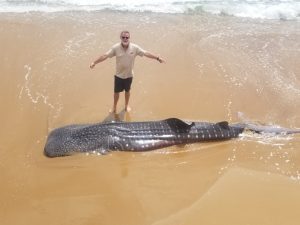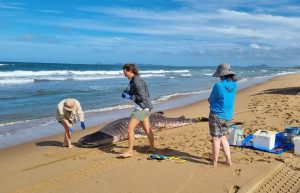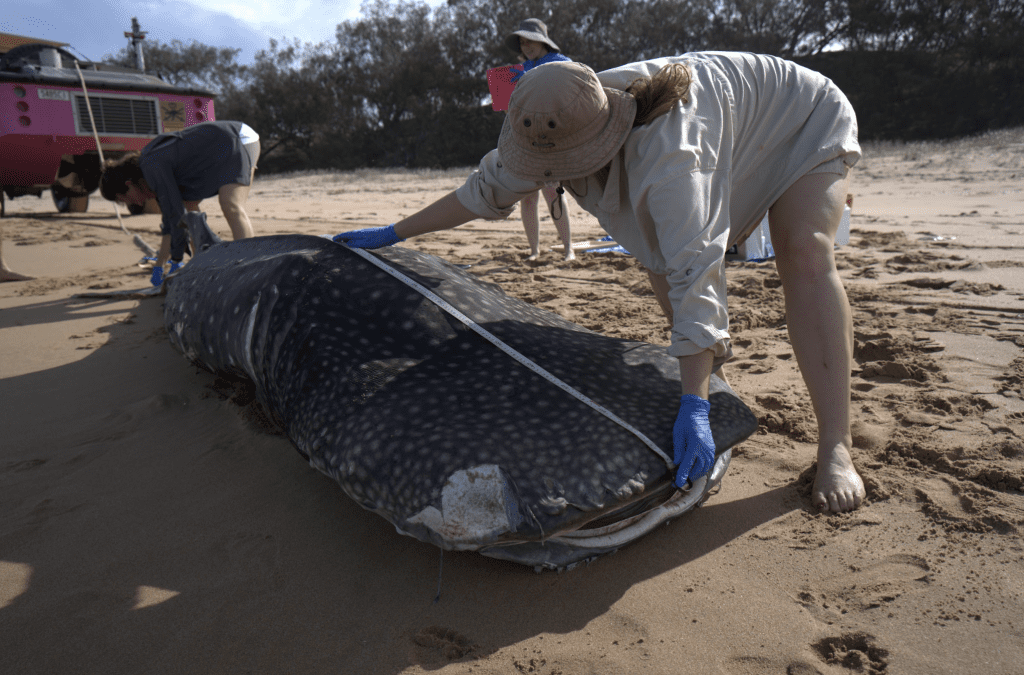19 Jan Whale Shark Stranding in 1770

Content warning: This article contains information and images (at the end) of a deceased animal that some people may find distressing.
A Heartfelt Mission: Responding to a Whale Shark Stranding
In the vast expanse of the Southern Great Barrier Reef, where our LARC! Tours venture, nature occasionally unfolds scenes that require both awe and solemnity. Such a moment occurred during a Paradise Tour when our head skipper, Antony, discovered a deceased whale shark on a Wednesday.
Reporting
Antony promptly initiated proper reporting procedures, swiftly notifying the strandings network at Queensland Parks and Wildlife Services. Regrettably, the QPWS team, constrained by resources, couldn’t dispatch someone to assess the situation. Determined to make a difference, former LARCette Jess tirelessly sought assistance.
Further Assistance
In the late hours, Jess’s call for help was answered by the remarkable Barbara Wueringer from Sharks and Rays Australia (SARA). Barbara’s commitment to marine life is unparalleled. She, in turn, coordinated efforts with Boating and Fisheries, securing a permit for three SARA researchers to visit the stranding site and collect valuable samples on Thursday.
Neil to the Rescue
Our very own LARCman Neil stepped in without hesitation, offering his services and our specialised LARC vessel ‘Shirley’ to transport the team 17km north of the Town of 1770 to the remote location. Upon arrival, the researchers wasted no time in delving into their important work.
Findings
The findings were both enlightening and sombre. The whale shark, a juvenile male, had an unknown cause of death. Samples were meticulously collected, including internal organs, vertebrae, jaw and skin. The stomach, strangely empty, posed mysteries. Dark green, almost black, bile raised concerns. As did the discovery of a tumour-like growth located where the intestine and stomach meet.
Afterwards
Following the meticulous work of the researchers, a thorough assessment was undertaken to eliminate any components of the whale shark that could potentially inflate, causing it to float. Once this process was complete, the majestic creature was tenderly returned to its home in the vast blue sea. As the whale shark gracefully descended into the depths, it transformed into a potential banquet for a myriad of marine creatures, offering a poignant reminder of the intricate circle of life beneath the waves.
A Greater Purpose
In the wake of this unusual occurrence, numerous questions persist, underscoring the rarity of such events. Nevertheless, this exceptional case stands as an invaluable treasure for researchers. The data acquired is a precious rarity, offering unprecedented insights into the lives of these majestic creatures. Beyond its scientific significance, it reinforces the crucial importance of marine conservation efforts.
In the midst of our sorrow over witnessing this tragic event, we are eternally thankful for the collective efforts made to ensure that the passing of the animal served a greater purpose. We extend a heartfelt shout-out and kindly ask you to join us in expressing support to the following people and organisations for their help in this situation:
Sharks and Rays Australia – Barbara, Nikki, Noemie, Lucy
Project Manta – Asia
Marine Megafauna Foundation – Simon
Sundive – David
Dive Spear & Sport 1770 – Jess

Skipper Antony using himself for scale for the initial report

SARA Researchers – Nikki, Noemie and Lucy.


No Comments